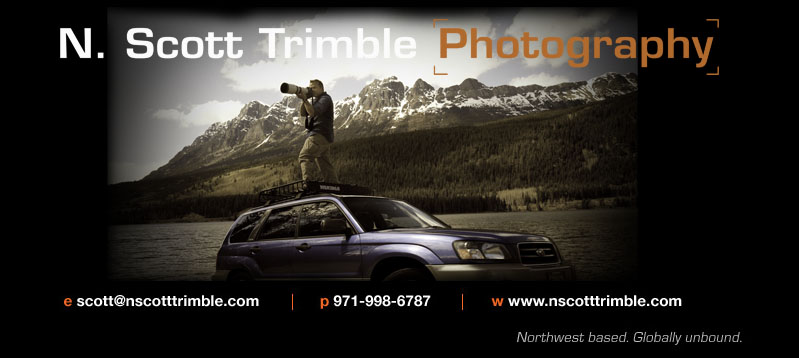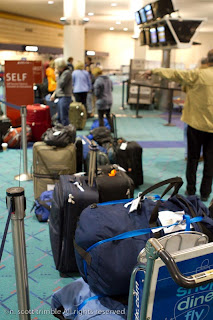I think the hardest part of planning a trip is the actual packing and departure. I have three bags to pack, four if you count the bag I gave to Capitol City to pack medical supplies. But let’s get back to the three I am pulling my hair out about.
My Lowepro backpack will take on my clothes, shoes, and necessities. I think it’s a 170 cu inch bag, so I have ten days of clothes (think synthetics that I plan to re-wear a few times.) Thick hiking boots, ( I am wearing my Nike Free’s for the looonngg plane ride.) My camera equipment belt pack with blister pods, a shotgun butte style steady camera rig for smoother handheld video, my tripod and video head, my nylon sleep sack, Aussie hat, flashlight, Leatherman, monopod, and an assortment of whatever else I already forgot and probably didn’t need but it seemed important to take along at the time.
My rolling camera bag with two cameras, my 300mm lens, 70-200mm, 16-35mm, 50 1.2 lens, 15mm fisheye, 24-70mm and two flashes, radio remotes, infrared remote, two camera strobes, and my laptop, with several power bars.
and finally my shoulder camera bag that has a video microlight, a book on Peruvian history, water bottle with ultraviolet light bug killer, hand sanitizer, toothpaste, and iphone.
Geez, now that I write this, I wish I had just brought an old Nikon FM2 and a few lenses and called it good!
The plan was to go to sleep at 8pm to get a good amount of shuteye before my friend Ron picked me up at 2:30am to go to the airport, but you know that never happened. I pack, repack, vacuum pack stuff and it still doesn’t fit right. I trimmed the clothes down even more, decided that shotgun mike just hasn’t got room, and there must be one more set of instructions for Jenn to follow regarding using the new oatmeal maker or something before I forget. So all in all, I get to bed at 11:15pm, and run inventories through my head (darn, gotta remember to pack ibuprofen just in case!) and probably drift off to sleep at around 12:30!
Yes, the set up to the travel I would say is the real pain!
Met the team at the airport with the huge throng of bags. The plan was to get early, check everything in straight to Cuzco and relax, but when we got there at 3am for the 6am flight, the computers are down, and there isn’t a soul at Delta! Turns out, they don’t come in until 4:30! Journalism 101–hurry up and wait.
When we finally do start check-in, we found out the second checked bag is now and extra $30. Okay, no problem, just have to readjust my finances to absorb that unexpected amount. Thanks Delta, always fun flying the unfriendly skies with you!
I figure the best chance to sleep on the plane is to snarf down some biscuits and country gravy. Airplane food, the stuff of champions! Too bad my eating experience would only go downhill from there.
Pineapple juice, Lima, and lessons learned
We arrived in Lima, Peru just after midnight. We did the zombie walk through customs and of course, my bags of attractive camera gear immediately red flags me to the bag search. Fortunately, everything cleared out, so we walked en masse into the common area that was...unexpected.
Ever since 9/11, airports in the U.S. don’t allow people past a certain point waiting for loved ones to come in. But even when they did, I don’t remember a flight I ever came in on that had what amounted to a small city population crammed in at the security checkpoint like what we walked into. As we walked through, some people would scream and bust out of the line, running to family members on our flight, impacting them with kisses and hugs and tears of joy. I didn’t have time to bust my gear out of my bags as we were coming through, and I was warned repeatedly that bags in the Lima Airport have a curious way of disappearing, even when practically attache to you, so opening my cases in 1000 plus people wasn’t the wisest thing to do, so the only photo I have is burned into my brain.
As we found a safe spot, we met up with our interpreter, Lauren, a 23 year old nutritional advisor from New York who met Dr. Shaw a few years ago in Ecuador, and has tagged along on his missions ever since. We formed a wagon train of bags and fortified ourselves behind them to reduce the chance of the bags growing Peruvian legs and marching off. We broke off in teams to scrounge around for food, massages, phone calls, or just walk the jet lag off.
Our flight was delayed from 5am to 9:40am, and as a result, we were given food vouchers to Dunkin Donuts or Mama Morenas. Some of us felt adventurous and tried Mama since doughnuts didn’t really suit the rumbling belly. Umm..if you ever have the choice–go doughnuts. We got dry and a little suspicious pork sandwiches and stale bread, but that was nothing to the juice. We were told they were from cartons, so Todd and I got Pineapple, and some others got orange juice. Well, one person who finished the orange juice discovered squirming maggots, which incited some squirming from the rest of us. I had taken a few sips of mine and sweated the agony to come. I knew better than to do the juice, but it just sounded so good! Most of us slumped into heaps on top of the softest bags we had and made the best of it. If you have a half body-sized bag, I highly suggest the pose with hands tucked under your back and legs Indian-style laying down, its not that uncomfortable!

We got our flight to Cuzco, and for some reason, I and five other team members scored first class seats. The comfortable, cushy seats eased our minds of the infected juice. Luckily, traveling with a medical team has it’s benefits. Namely, Bactrim. We started a regimen immediately, which didn’t help my nerves when my belly finally started rumbling when we landed in Cuzco.
We departed the plane, and met Guido del Prado, founder of the Kausey Wasi Clinica in Coya. he arranged for several vans to take us and our stuff to Coya. We drove through the tightly packed, ancient looking city that served as the home base of the Inca for hundreds of years before Pizarro devastated the area, and the people. We passed terraced mountainsides lush with a tropical green, and ancient ruins. Coya lies several thousand feet down from 11,000 Cuzco at entrance to the Sacred Valley of the Inca, a beautiful, amazing place.

Rumbling stomach aside, we dropped off our bags at the team’s hotel and we footed it over to the clinic. Hundreds of parents and children patiently waited for us and we jumped right into triage. Some of the people walked days and days to get a chance to be helped by Dr. Shaw’s medical team, up and down mountains that would be an unimaginable journey for Americans to contemplate.
Thank God for the video on my cameras, or I wouldn’t have been able to recount at think on this first day, we were ALL beyond zombie-ism
Sandy, Guido’s wife and an Oregonian, took me over across the courtyard to Martha’s place while I am staying. Martha kind of reminds me of Chachi’s mom in Joannie Loves Chachi. The outside of her home is part of the wall of structures that make up the courtyard. She has a store selling soda and necessities. The inner courtyard has guest rooms on one side, and her home on the other. The rooms are quaint, red and peach walls with a double bed, little nightstand and wood beams more like tree limbs.
The shower is a shower head with an electrical wire sticking out of it connected to a circuit breaker. You turn the circuit breaker and pray it doesn’t get wet!
It was a little to sophisticated for me to figure out, so I settled for a cold shower.

































